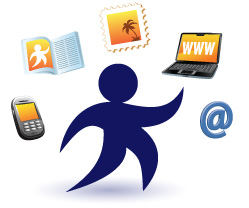
|
Adding Social Media and Mobile to Your Direct Fundraising
|
|
Posted by at Feb 14, 2013 07:00 AM CST
|
 Email, Facebook, Twitter, mobile… it can be confusing for nonprofit organizations to choose where they should communicate with donors. It can be confusing for donors, too.
Email, Facebook, Twitter, mobile… it can be confusing for nonprofit organizations to choose where they should communicate with donors. It can be confusing for donors, too.
Donors, even older donors, are embracing a wide variety of communication channels, and they will continue to do so in the coming years. The answer? Nonprofits can make the following channels work better individually by making them work together:
- Direct mail
- Voice telephone (incoming phone calls)
- Online social media (Facebook, Twitter, Pinterest etc.)
- Events
- Mobile
The growth of social media and mobile has been rapid, even among seniors who make up a majority of the donor base for some nonprofits. Consider just a few statistics:
- Smartphone growth is growing to the point that more Americans have smartphones than the previous generation of “feature phones.” Yes, it’s growing faster among young people, but it is growing all the way up the age demographic:
- 13% of all seniors (65+ years of age) have a smart phone, but that represents an average between 5% of low-income seniors and 27% of seniors with incomes of $30,000 or more. Yes, five percent of “poor” seniors actually have a smartphone!
- 32% of adults 55-64 and 44% of adults 45-54 have smartphones, and they’re not likely to give them up as they mature into their prime giving years.i
- Remember, five years ago 0% of adults had smartphones.
- Smartphone users do lots more than talk and text:
- 84% of smartphone users access the Internet on their phone.
- 76% send and receive email.
- 59% access social media.
- More than 50% shoot, send, receive and watch photos and videos and post them to online social media on their phones.
- 37% do some online banking on their phones (this indicates a willingness to use the device to conduct financial transactions like donations).ii
- “Twitter users are more interested in connecting with public figures than are social media users who do not use Twitter.” 11% of Twitter users say that “reading comments by politicians, celebrities or athletes is a major reason they use online social networks,” compared with just 4% of users of other online social networks. Isn’t it conceivable that they’d equate the leader of your organization at least as high as Justin Bieber?iii
- Amergent's Vital Signs Analysis™ of Catholic clients’ donor files indicates that donors who have provided an email address to the organization give more often, and at a higher amount, than their cohorts without an email address. The result is usually two or two-and-one-half times the total donor value. This proves that it pays to converse with your donors across multiple channels.
With these facts in mind, here are five ideas to help you interact with your donors across these channels:
- Improve your email performance by combining your email messaging with your social media presence. Use snippets of your email content to create Facebook posts and Twitter tweets. Social media expands your reach because it meets your supporters where they “live.” With consistent messaging across channels, it can help increase open rates and boost overall conversion.
- Text-to-give is NOT a significant part of fundraising. After some $40 million was raised in $10 gifts through cell phones for the Haiti earthquake response in January, 2010, every nonprofit had dreams of cell phones as mobile donation machines. Even for the Red Cross, those dreams seem to have evaporated. Until the next world-wide disaster that spurs televised fundraising specials, it will have limited impact. And when that happens, only a handful of big-name disaster response nonprofits will benefit. Pollyanna would look on the bright side and say, “Millions of people got comfortable using their mobile phones to make a donation to a charity. Maybe now they’ll be more likely to use their phone to make a gift via a web page in response to my email.” And, she’d be right.
- Use your direct mail packages to support others channel and vice versa. Test every change you make in your mail, since this is probably your bread-and-butter fundraising channel.
- Ask for mobile numbers (but don’t require it) on your donation form and newsletter signup form. If you can associate phone numbers with donors, you can track the impact of mobile communications, and you can reach out to donors via phone when their mail and email start bouncing.
- Always try to tie all your donor data together into one donor record: postal address, email, home phone, mobile phone, twitter handle, whether they are a Facebook fan. This will help you segment your file but will also help you to validate the added value of contact through each of these channels.
Since the future of mobile and online social networking is growing, it pays to recognize its potential for your organization. Choose one area where you think mobile and/or social media can be effective for your organization and get started!
i Pew Internet: “Nearly half of American adults are smartphone owners” Mar 1, 2012
ii Pew Internet: “Americans and Their Cell Phones” Aug 15, 2011
iii Pew Internet: “Why Americans use social media” Nov 15, 2011


















